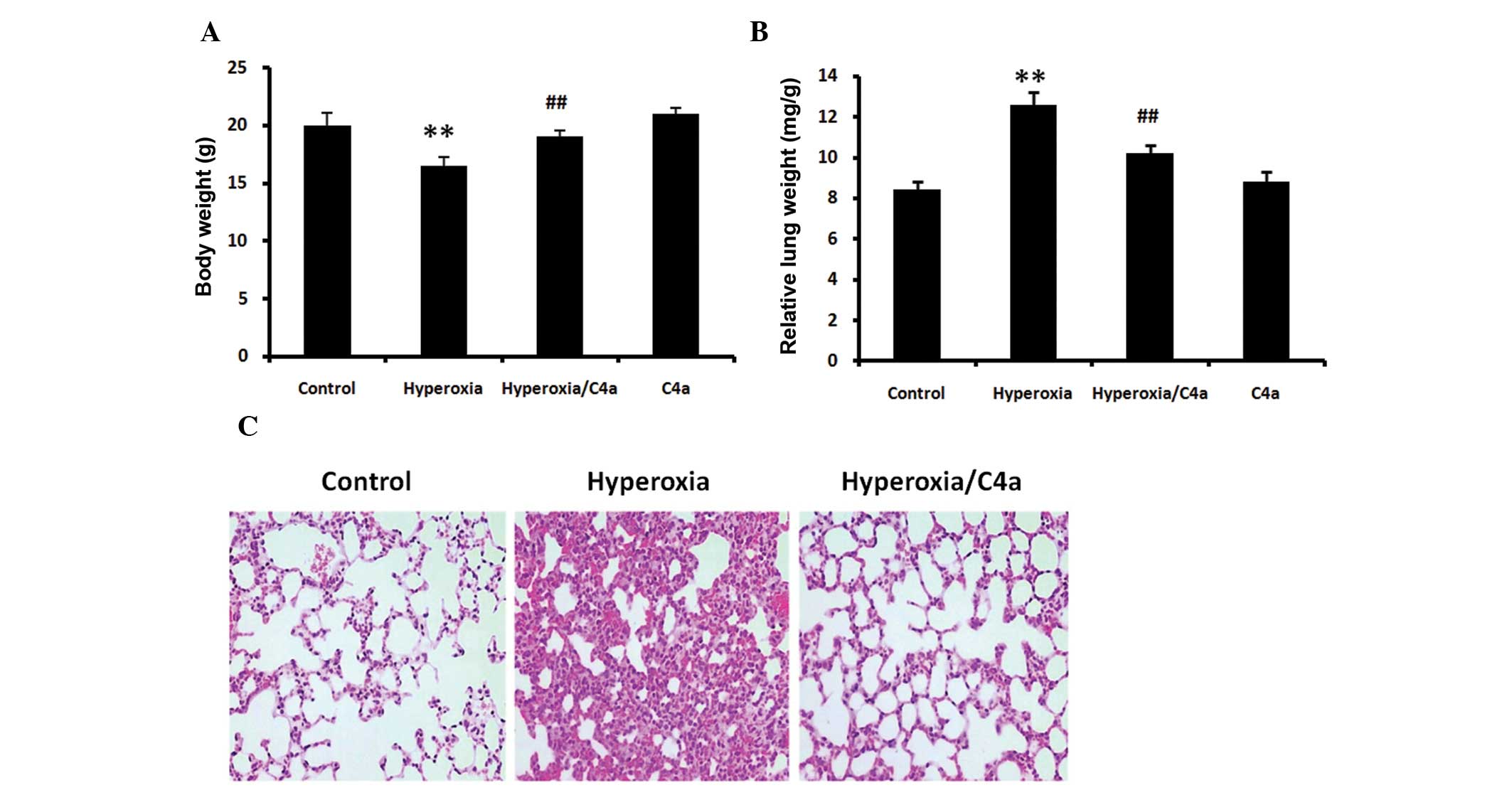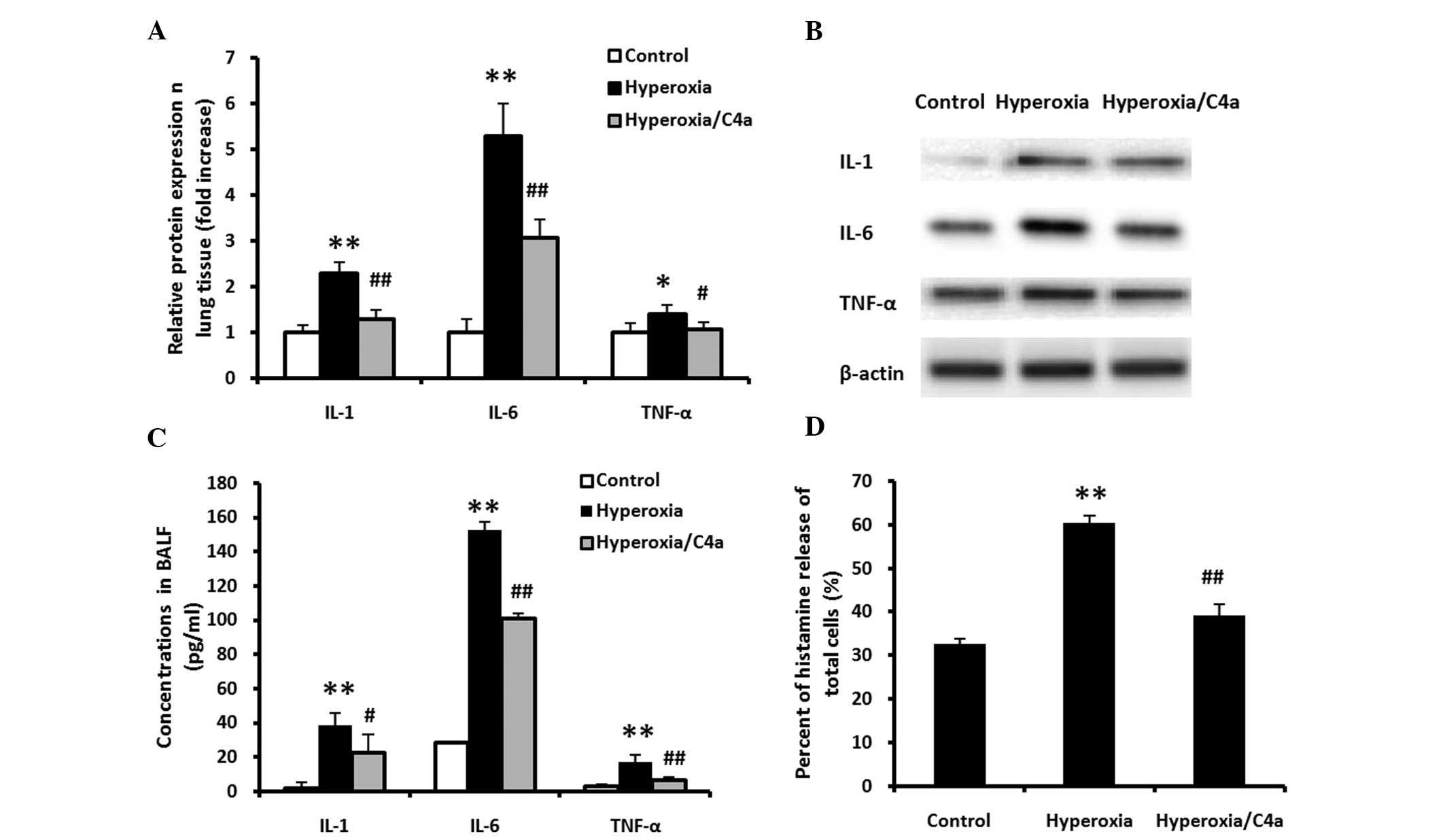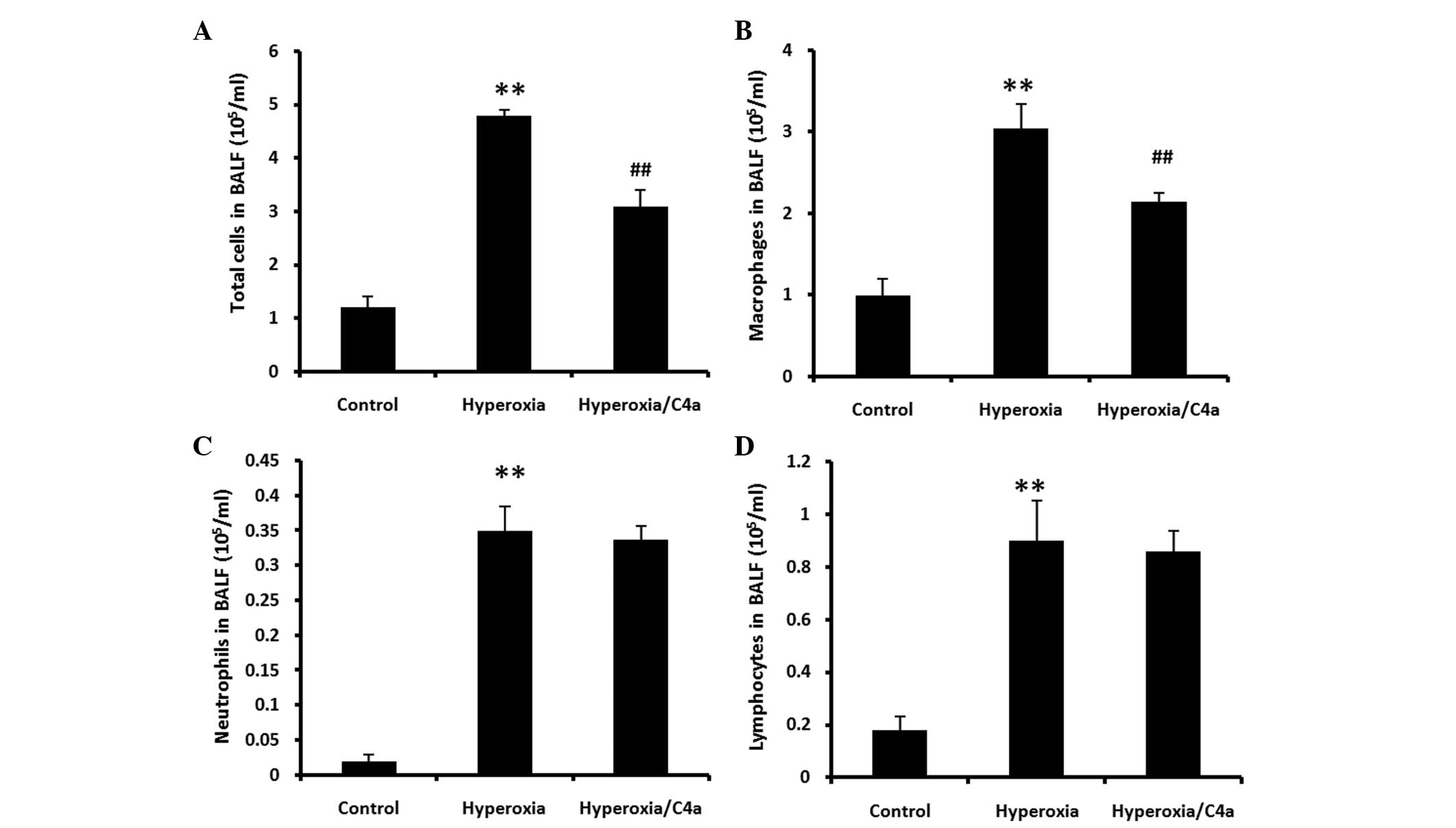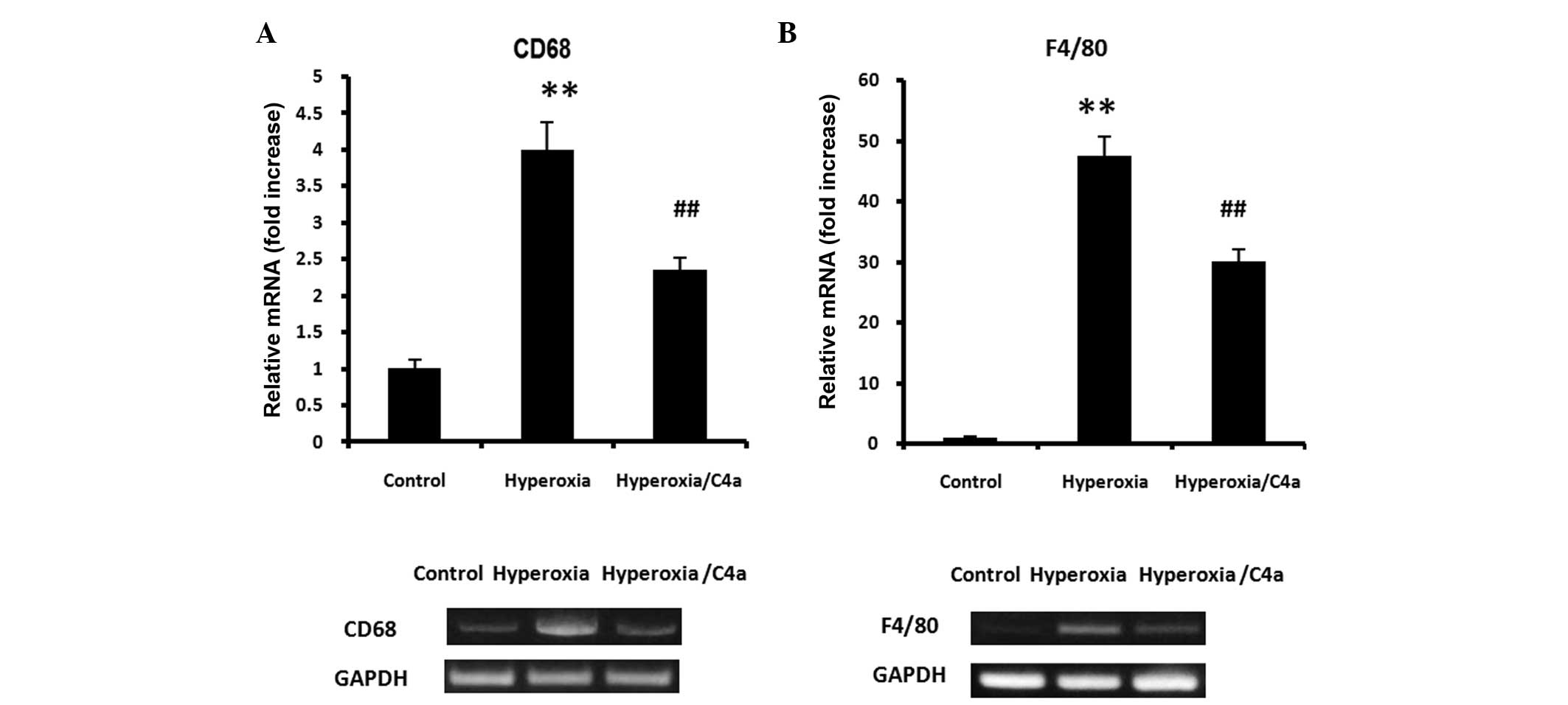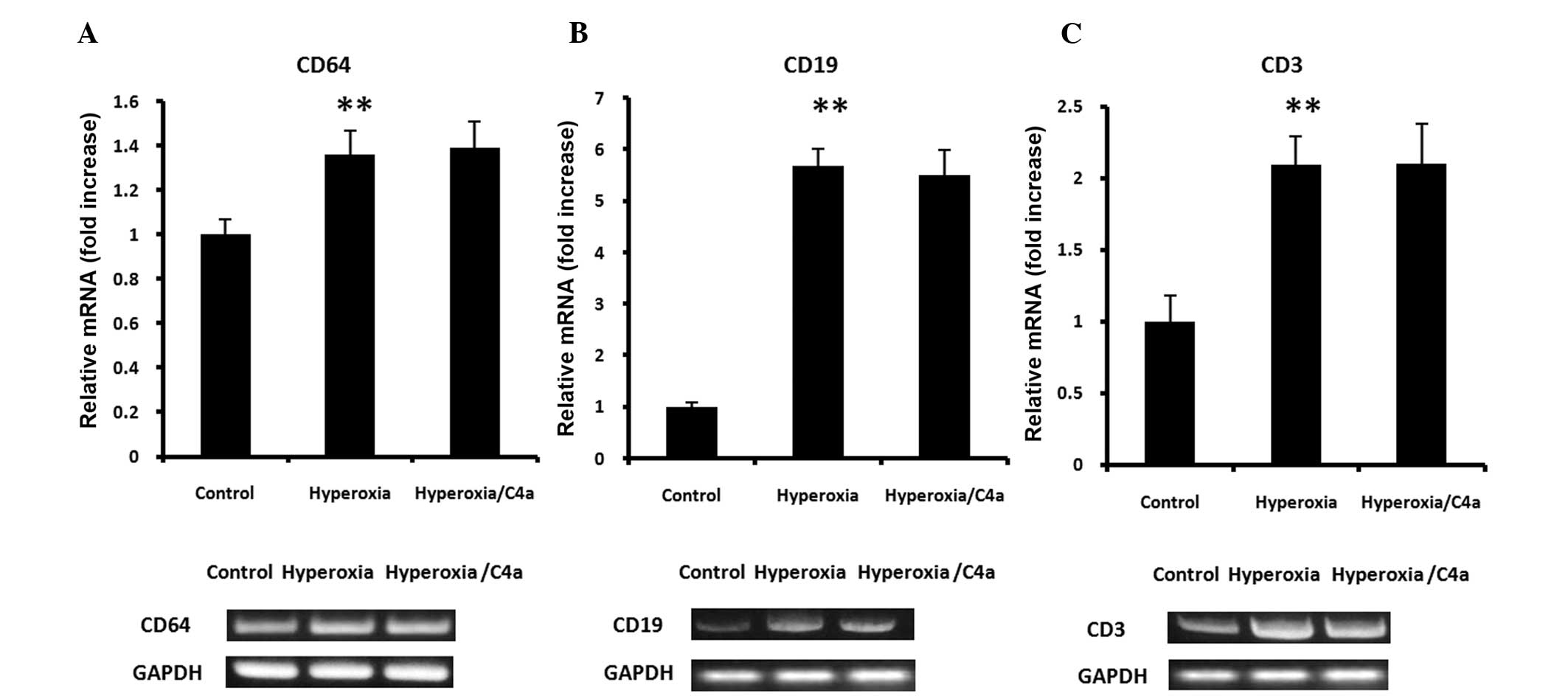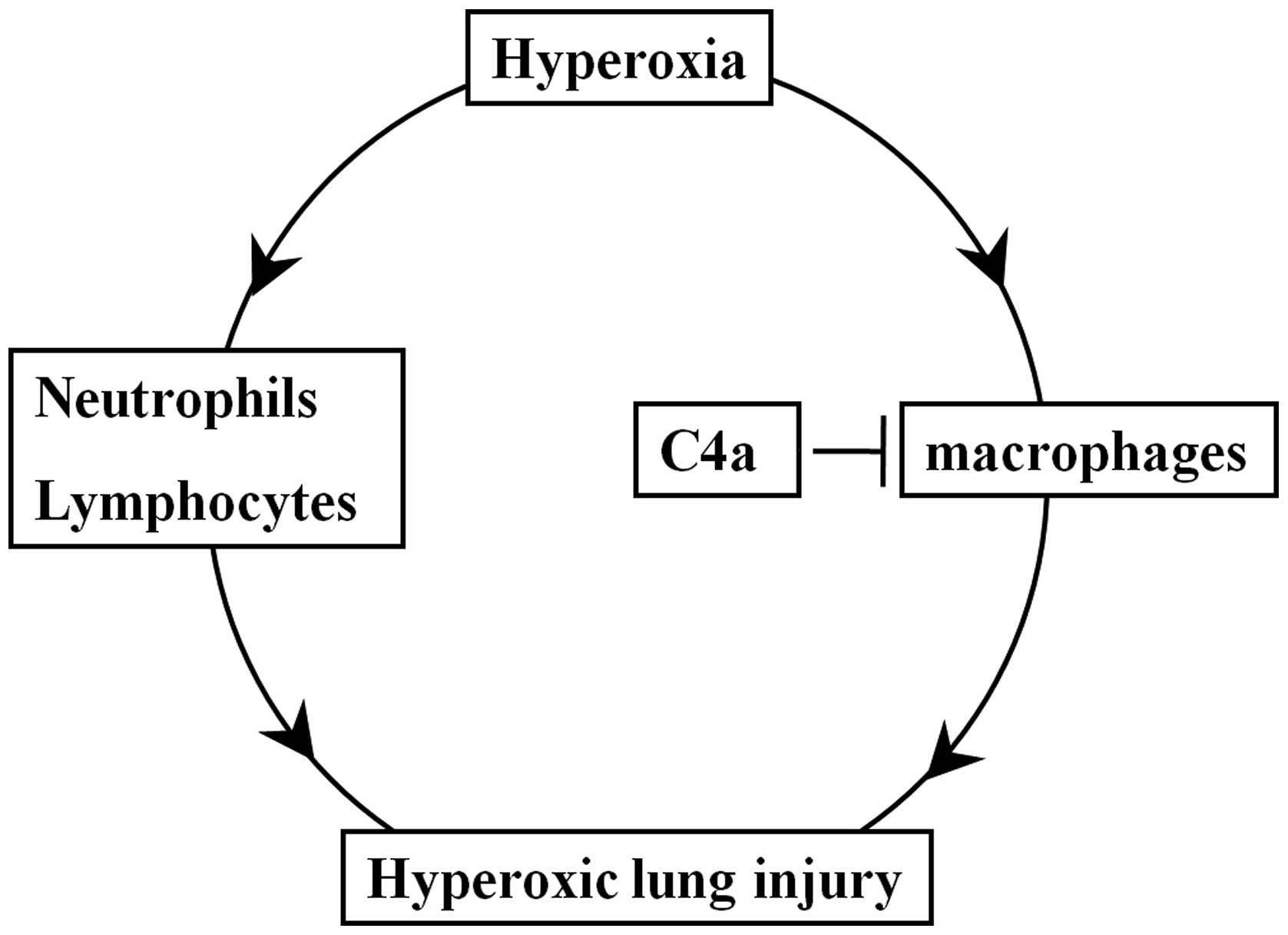Protective effect of C4a against hyperoxic lung injury via a macrophage‑dependent but not a neutrophil/lymphocyte‑dependent signaling pathway
- Authors:
- Published online on: December 7, 2015 https://doi.org/10.3892/mmr.2015.4651
- Pages: 1250-1256
Abstract
Introduction
High oxygen mechanical ventilation is widely used in clinical settings to treat hypoxemia, which occurs in various diseases (1). High oxygen mechanical ventilation is important for treating severe respiratory conditions, such as respiratory failure and acute respiratory distress syndrome (ARDS) (2). However, a study demonstrated that exposure to high levels of oxygen for prolonged periods of time may actually result in acute inflammatory reactions and lung injury (3). Therefore, there is a strong requirement for a therapeutic strategy that will alleviate hyperoxia-induced lung injury.
Interest in complement molecules has increased globally and research has been conducted on the role of complement anaphylatoxins in a number of diseases (4). Notably, complement anaphylatoxin C4a, released from the N-terminal region of the parental protein α-chain, has been investigated (5). It has been demonstrated that C4a is a potent soluble anaphylotoxic and anti-chemotactic inflammatory regulator, it inhibits the recruitment and activation of monocytes/macrophages that are induced by C5a (6). Since C4a is able to inhibit chemoattractants and secretagogues in inflammatory reactions, the aim of the present study was to determine whether C4a inhibits hyperoxic-induced lung injury. Excessive high oxygen mechanical ventilation leads to lung injury, and provokes the secretion of cytokines and chemokines, such as interleukin (IL)-1, IL-6 and tumor necrosis factor-α (TNF-α) (7), which results in inflammatory cell infiltration (8). C4a is released from the fourth component of complement C4 during activation of the complement classical pathway and lectin pathway (6). As it is a natural potential factor in the human body, it is hypothesized that it may have potential in clinical application. To the best of our knowledge, the present study provides the first evidence of C4a-mediated effects during hyperoxic lung injury, and the results indicated that C4a may prove to be a novel therapeutic strategy for alleviating hyperoxic lung injury.
Materials and methods
Animals
The experiments were conducted in the Animal Experimental Center of the Mudanjiang Medical University (Mudanjiang, China). All animal care and experimental protocols were in accordance with the Animal Experiment Guidelines of the Mudanjiang Medical University, and ethical approval was obtained from the Mudanjiang Medical University. Male BALB/c mice (Kyudo Co., Ltd., Saga, Japan), aged 6–8-weeks, were fed normal chow and water ad libitum. The mice were divided into three groups (6 mice per group) and ventilated with 100% oxygen for 36 h, as described previously (9). Recombinant C4a (1 µg/25 g of body weight; BioMart, Nanjing, China) was administered via an ALZET mini-osmotic pump (American Health & Medical Supply International Corp. Co., Ltd., Scarsdale, NY, USA) immediately following exposure to 100% oxygen, as previously described by Takao et al (10). Following 100% oxygen exposure for 36 h, the mice were sacrificed using chloral hydrate (0.03ml/10g body weight; Sigma-Aldrich, St. Louis, MO, USA) and lung tissue samples were harvested for experimental use. The body and relative lung weights of the mice were determined.
Morphometric analysis
Paraffin-embedded lung tissue samples were observed by conventional light microscopic examination. Lung tissue sections (5 mm) were stained with hematoxylin and eosin (Sigma-Aldrich), and assessed in a double-blinded manner. An automatic Provis AX-70 microscope with a camera (Olympus Corporation, Tokyo, Japan) was used to capture the microscopy images of the lung samples. Morphometric analyses of the lung tissue samples were performed using NIH 1200 image analysis software (Image J version 1.45; National Institutes of Health, Bethesda, MA, USA), as previously described (11).
Western blot analysis
According to a method described by Laemmli (12), the proteins from the lung tissue samples were isolated according to the method described in (2) and separated using a vertical slab gel containing 12% poly-acrylamide (Sigma-Aldrich). Proteins were transferred to a nitrocellulose membrane (Bio-Rad Laboratories, Inc., Hercules, CA, USA) electrophoretically, as previously described by Kyhse-Andersen (13), with minor modifications, using a Semi-Dry Electroblotter (Sartorius AG, Göttingen, Germany) for 90 min at 15 V. The membrane was then treated with Block Ace™ (4%; Sigma-Aldrich) for 30 min at 22°C. Polyclonal rabbit anti-human immunoglobulin (IgG) anti-IL-1 (cat. no. SAB4503272), anti-IL-6 (cat. no. I2143) and goat IgG anti-TNF-α (cat. no. T1816) primary antibodies (all Sigma-Aldrich) in phosphate-buffered saline supplemented with 0.03% Tween® 20 (PBST; Sigma-Aldrich) were added to the membranes at a dilution of 1:500 and incubated for 1 h at 22°C. Following washing with PBST, membranes were incubated with horseradish peroxidase (HRP)-conjugated anti-rabbit IgG, and anti-goat IgG (20 ng/ml) for 30 min at 22°C. Following further washing, an enhanced chemiluminescence (ECL) reaction was performed using an ECL Plus Western Blotting Detection system™ (GE Healthcare Life Sciences, Shanghai, China). β-actin served as the internal control (Sigma-Aldrich). The images of the gels on film were acquired and analyzed automatically with Gel-Pro Analyzer 4.0 software (Media Cybernetics, Inc., Rockville, MD, USA).
Preparation of the bronchoalveolar lavage fluid (BALF)
Following sacrifice, surgery was performed on the mouse chests to expose the lung. Whole lung lavage was performed four times with injections of 0.5 ml sterile saline through a 21 G flat syringe needle (BioMart, Shanghai, China) cannulated 0.7 cm into the trachea. BALF was recovered from each mouse for quantitative cell counting. The total number of cells was counted using a hemocytometer (Countess® II Automated Cell Counter, AMQAX1000; Invitrogen; Thermo Fisher Scientific, Inc., Waltham, MA, USA), and cell differentiation was determined for >500 cells placed on cytocentrifuge slides treated with Wright-Giemsa staining (Sigma-Aldrich), as previously described (14). A 100 ml aliquot of BALF was used for the total cell count, and the remainder of the BALF was immediately centrifuged at 1,000 × g for 10 min. Macrophages (contained in the precipitate) were isolated from the BALF. The BALF supernatants were stored at −80°C for further cytokine and chemokine analysis.
Measurement of histamine release
The histamine release reaction was assessed as previously described (15). Briefly, total cells in BALF (2×106 cells/ml) were kept in cell medium (containing 150 mM NaCl, 3.7 mM KCl, 3 mM Na2HPO4, 3.5 mM KH2PO4, 5.6 mM glucose, 0.1% gelatin, 0.1% bovine serum albumin, and 1 mM CaCl2, pH 6.8). Following centrifugation at 10,000 × g for 1 min at 22°C, the supernatant was collected, and the precipitated cells were lysed in mast cell medium (Guidechem, Shanghai, China) supplemented with 2% Triton X-100 (1 ml; Sigma-Aldrich) for 30 min at 37°C. This analysis was performed using the F-2500 quantification system with FL Solutions (Hitachi Ltd., Tokyo, Japan) by calculating the ratio of fluorescent signal to histamine concentration. Histamine concentrations in the supernatant and in the cell lysate were measured as the fluorescent signal observed at 22°C with excitation and emission wavelengths of 360 nm and at 450 nm, respectively. The results were presented as the percent ratio of released histamine in the supernatant to the total cellular histamine content, using the following equation: Amount of histamine in the supernatant/total amount of histamine in the supernatant and in the cell lysate × 100.
Enzyme-linked immunosorbent assay (ELISA)
BALF was collected for the IL-1, IL-6 and TNF-α assays, which were conducted using the respective mouse ELISA kits (Sigma-Aldrich). The ELISA plates were coated with 100 µl capture antibody per well at 4°C overnight. Following washing, with washing buffer contained in the ELISA kit, 200 µl assay dilution buffer (from the ELISA kit) was added per well for blocking at room temperature for 1 h. The serially diluted samples were added to the plate and incubated at 4°C overnight. HRP-conjugated avidin was added after coating with detection antibody, and the samples were incubated at room temperature for 30 min. The substrate 3,3′,5,5′-tetramethylbenzidine (Sigma-Aldrich) was added and the solution was incubated for 15 min. Subsequently, 2NH2SO4 was added to stop the reaction and absorbance was measured at 450 nm using an ELISA MTP-800 microplate reader (Corona Electric, Tokyo, Japan).
Reverse transcription-quantitative polymerase chain reaction (RT-qPCR)
Total RNA was extracted from the lung tissue samples using TRIzol (Invitrogen; Thermo Fisher Scientific, Inc.) and relative mRNA expression was normalized to glyceraldehyde 3-phosphate dehydrogenase (GAPDH). The following primers were used: CD68 forward, 5′-CATCAGAGCCCGAGTACAGTCTACC-3′, and reverse, 5′-AATTCTGCGCCATGAATGTCC-3′; F4/80 forward, 5′-GAGATTGTGGAAGCATCCGAGAC-3′, and reverse, 5′-GATGACTGTACCCACATGGCTGA-3′; CD64 forward, 5′-CTTCTCCTTCTATGTGGGCAGT-3′, and reverse, 5′-GCTACCTCGCACCAGTATGAT-3′; CD19 forward, 5′-CCACAAAGTCCCAGCTGAAT-3′, and reverse, 5′-GGGGTCCCAGATTTCAAAGT-3′; CD3 forward, 5′-CAGCCTCTTTCTGAGGGAAA-3′ and reverse, 5′-AGGATTCCATCCAGCAGGTA-3′; and GAPDH forward, 5′-GCACCGTCAAGGCTGAGAAC-3′, and reverse, 5′-TGGTGAAGACGCCAGTGGA-3′. An RNase-Free kit (Roche Diagnostics (Shanghai) Ltd., Shanghai, China) was used with the following reaction conditions: 37°C for 20 min, 75°C for 10 min and maintained at 4°C, and a Transcriptor First Strand cDNA Synthesis kit (Roche Diagnostics (Shanghai) Ltd.) was used with the following reaction conditions: 55°C for 30 min, 85°C for 5 min and maintained at 4°C. RT-qPCR was performed using the ABI 7300 Fast Real-Time PCR system (Applied Biosystems; Thermo Fisher Scientific, Inc.).
Statistical analysis
The paired Student's t-test was used to analyze the data. Analyses were conducted using SPSS 17.0 (SPSS, Inc., Chicago, IL, USA) and the data are expressed as the mean ± standard deviation, and each experiment was repeated in triplicate. P<0.05 was considered to indicate a statistically significant difference.
Results
Hyperoxia-induced body and lung weight alterations are reduced by C4a
The BALB/c mice were ventilated with 100% oxygen for 36 h with or without C4a treatment in conjunction. Following hyperoxic treatment alone, the body weights of the mice were significantly reduced (Fig. 1A, P<0.01) and the relative lung weight was significantly increased (Fig. 1B, P<0.01). C4a significantly reduced these changes in body weight and relative lung weigh compared with the hyperoxia alone-treated mice (Fig. 1A and B).
Hyperoxia-induced morphological changes in lung tissue are attenuated by C4a
The BALB/c mice were ventilated with 100% oxygen for 36 h with or without C4a treatment and lung morphological changes were analyzed. Hyperoxia induced increases in thickness of the alveolar walls and inflammatory cell infiltration in the lung tissue. However, treatment with C4a attenuated the hyperoxia-induced morphological changes, as shown in Fig. 1C.
Hyperoxia-induced inflammatory reaction in lung tissue and BALF samples is attenuated by C4a
The BALB/c mice were ventilated with 100% oxygen for 36 h with or without C4a treatment, prior to lung tissue and BALF sample harvesting. The expression levels of IL-1, IL-6 and TNF-α in the lung tissue samples (Fig. 2A and B) and BALF (Fig. 2C), and the histamine release levels in the total cells in the BALF (Fig. 2D), were significantly increased following treatment with 100% oxygen. Hyperoxia-induced expression of IL-1, IL-6 and TNF-α in lung tissue and BALF and histamine release of total cells in BALF were significantly reduced by treatment with C4a (Fig. 2; P<0.01).
C4a attenuated the hyperoxia-induced macrophage infiltration, but not neutrophil or lymphocyte infiltration in BALF
BALF samples were collected following ventilation with 100% oxygen for 36 h with or without C4a treatment (Fig. 3). Hyperoxia significantly induced inflammatory cell infiltration in BALF (P<0.01). The hyperoxia-induced macrophage infiltration was significantly reduced by treatment with C4a (Fig. 3B; P<0.01). However, C4a treatment did not reduce neutrophil or lymphocyte infiltration (Fig. 3C and D).
C4a attenuated the hyperoxia-induced macrophage infiltration, but not neutrophil or lymphocyte infiltration in lung tissue samples
As markers of macrophages, CD68 and F4/80 mRNA expression levels were detected in the lung tissue samples. The expression of CD68 and F4/80 mRNA in the lung tissue was significantly induced by hyperoxia, however, treatment with C4a significantly suppressed CD68 and F4/80 mRNA expression levels (Fig. 4; P<0.01). Furthermore, mRNA expression of CD64 (neutrophil marker), CD19 (B lymphocyte marker) and CD3 (T lymphocyte marker) were detected in the lung tissue samples. Hyperoxia significantly increased the mRNA expression levels of CD64, CD19 and CD3 in the lung tissue samples. However, the hyperoxia-induced CD64, CD19 and CD3 mRNA expression levels were not suppressed by C4a treatment (Fig. 5).
Discussion
To the best of our knowledge, the present study reported the first evidence of complement anaphylatoxin C4a-mediated action during hyperoxic lung injury in mice. In recent years, complement anaphylatoxin research has intensified, particularly in a number of diseases, such as hepatitis C, cardiovascular disease, immunological diseases and tumors (4,6,14,16). Complement anaphylatoxin C4a, an important member of the complement anaphylatoxin family, has also been investigated (5). C4a, which is liberated from the N-terminal region of the parental protein α-chain, was previously isolated from the inflammatory joint fluid of patients with rheumatoid arthritis (16,17). C4a is able to inhibit the effects of chemoattractants and secretagogues in inflammatory reactions (5,14). However, the role of C4a in hyperoxic lung injury has yet to be elucidated.
Respiratory failure and acute respiratory distress syndrome (ARDS) are common diseases in the clinic (1). As a clinical therapy, mechanical ventilation with high oxygen is widely used in the treatment of the hypoxemia associated with various diseases (2,18). However, as shown in a previous study, prolonged exposure to hyperoxia can lead to inflammatory reactions and lung injury (3). As a consequence, identifying novel therapeutic strategies to alleviate hyperoxic lung inflammatory and injury is required. As C4a is able to inhibit chemoattractants and secretagogues in inflammatory reactions (5,6,14), it was hypothesized that C4a could inhibit hyperoxic lung injury.
The present study provided, to the best of our knowledge, the first analysis of the effects of C4a against hyperoxic lung injury. Excessive high oxygen mechanical ventilation leads to lung injury and provokes the secretion of cytokines and chemokines, such as histamine, IL-1, IL-6 and TNF-α (6,19,20), which results in inflammatory cell infiltration (7). IL-1 and IL-6 are involved in pro- and anti-inflammatory responses via the regulation of leukocyte function and apoptosis (19,21). IL-1 and IL-6 have been reported to beneficially regulate neutrophil adhesion and migration (22). Elevated IL-1 and IL-6 expression levels have been demonstrated in the majority of lung injury models, suggesting they may be biological markers of lung injury (23,24). TNF-α is also a canonical inflammatory cytokine that promotes the inflammatory response, such as inflammatory cell migration and proliferation (25). Treatment with 100% oxygen led to lung injury and marked morphological changes. To improve the current understanding of hyperoxia-induced lung injury, the expression levels of IL-1, IL-6 and TNF-α in lung tissue samples and BALF, and the histamine release from the cells in BALF were examined. Hyperoxia significantly increased the expression levels of IL-1, IL-6 and TNF-α in lung tissue samples and BALF, and also increased the histamine release levels in total cells. Hyperoxia-induced lung injury, lung morphological changes and inflammatory reaction in the lung tissue samples and BALF were all significantly attenuated following treatment with C4a.
This study showed that hyperoxia significantly increased the total cell count, as well as the numbers of macrophages, neutrophils and lymphocytes in the BALF. C4a significantly attenuated the hyperoxia-induced increase in the number of macrophages. These results are consistent with previous results, which demonstrated that hyperoxia could recruit inflammatory cells, such as macrophages, lymphocytes and neutrophils (26). However, the increased numbers of neutrophils and lymphocytes were not affected by treatment with C4a. Furthermore, the mRNA expression levels of CD68 and F4/80, indicators of macrophage accumulation; CD64, a neutrophil marker; CD19, a B lymphocyte marker; and CD3, a lung tissue T lymphocyte marker, were significantly increased by hyperoxia. The mRNA expression levels of CD68 and F4/80 in lung tissue samples significantly reduced following treatment with C4a, as compared with the hyperoxia-only group. Conversely, treatment with C4a did not affect the mRNA expression levels of CD64, CD19 or CD3 in the murine lung tissue samples. These results were concordant with those of a previous study which demonstrated that C4a is a monocyte and macrophage migration inhibitory factor, and the C4a receptor is restricted to monocytes and macrophages (27). As shown in Fig. 6, hyperoxia induced lung injury, lung morphological changes, and inflammatory reactions, which were attenuated by treatment with C4a. C4a acted via a macrophage-dependent but not a neutrophil/lymphocyte-dependent signaling pathway. However, as a novel therapeutic strategy for hyperoxic lung injury, treatment with C4a requires further investigation.
In conclusion, to the best of our knowledge, the present study is the first to demonstrate the crucial role of C4a in the attenuation of hyperoxia-induced lung injury, and provides a rationale for the potential use of C4a in clinical settings to treat acute exacerbation of hyperoxic lung injury.
References
|
Vitacca M, Bianchi L, Bazza A and Clini EM: Advanced COPD patients under home mechanical ventilation and/or long term oxygen therapy: Italian healthcare costs. Monaldi Arch Chest Dis. 75:207–214. 2011. | |
|
Xu Y, Tian Z and Xie P: Targeting complement anaphylatoxin C5a receptor in hyperoxic lung injury in mice. Mol Med Rep. 10:1786–1792. 2014.PubMed/NCBI | |
|
Vosdoganes P, Lim R, Koulaeva E, Chan ST, Acharya R, Moss TJ and Wallace EM: Human amnion epithelial cells modulate hyperoxia-induced neonatal lung injury in mice. Cytotherapy. 15:1021–1029. 2013. View Article : Google Scholar : PubMed/NCBI | |
|
Imakiire K, Uto H, Sato Y, Sasaki F, Mawatari S, Ido A, Shimoda K, Hayashi K, Stuver SO, Ito Y, et al: Difference in serum complement component C4a levels between hepatitis C virus carriers with persistently normal alanine aminotransferase levels or chronic hepatitis C. Mol Med Rep. 6:259–264. 2012.PubMed/NCBI | |
|
Hugli TE: Biochemistry and biology of anaphylatoxins. Complement. 3:111–127. 1986.PubMed/NCBI | |
|
Zhao Y, Xu H, Yu W and Xie BD: Complement anaphylatoxin C4a inhibits C5a-induced neointima formation following arterial injury. Mol Med Rep. 10:45–52. 2014.PubMed/NCBI | |
|
Pushparaj PN, Tay HK, Wang CC, Hong W and Melendez AJ: VAMP8 is essential in anaphylatoxin-induced degranulation, TNF-alpha secretion, peritonitis and systemic inflammation. J Immunol. 183:1413–1418. 2009. View Article : Google Scholar : PubMed/NCBI | |
|
Davies J, Karmouty-Quintana H, Le TT, Chen NY, Weng T, Luo F, Molina J, Moorthy B and Blackburn MR: Adenosine promotes vascular barrier function in hyperoxic lung injury. Physiol Rep. 2:e121552014. View Article : Google Scholar : PubMed/NCBI | |
|
Mikawa K, Nishina K, Maekawa N and Obara H: Attenuation of hyperoxic lung injury in rabbits with superoxide dismutase: Effects on inflammatory mediators. Acta Anaesthesiol Scand. 39:317–322. 1995. View Article : Google Scholar : PubMed/NCBI | |
|
Takao Y, Mikawa K, Nishina K, Maekawa N and Obara H: Lidocaine attenuates hyperoxic lung injury in rabbits. Acta Anaesthesiol Scand. 40:318–325. 1996. View Article : Google Scholar : PubMed/NCBI | |
|
Runzi M, Raptopoulos V, Saluja AK, Kaiser AM, Nishino H, Gerdes D and Steer ML: Evaluation of necrotizing pancreatitis in the opossum by dynamic contrast-enhanced computed tomography: Correlation between radiographic and morphologic changes. J Am Coll Surg. 180:673–682. 1995.PubMed/NCBI | |
|
Laemmli UK: Cleavage of structural proteins during the assemblyof the head of bacteriophage T4. Nature. 227:680–685. 1970. View Article : Google Scholar : PubMed/NCBI | |
|
Kyhse-Andersen J: Electroblotting of multiple gels: A simple apparatus without buffer tank for rapid transfer of proteins from polyacrylamide to nitrocellulose. J Biochem Biophys Methods. 10:203–209. 1984. View Article : Google Scholar : PubMed/NCBI | |
|
Tsuruta T, Yamamoto T, Matsubara S, Nagasawa S, Tanase S, Tanaka J, Takagi K and Kambara T: Novel function of C4a anaphylatoxin. Release from monocytes of protein which inhibits monocyte chemotaxis. Am J Pathol. 142:1848–1857. 1993.PubMed/NCBI | |
|
Nishiura H, Tokita K, Li Y, Harada K, Woodruff TM, Taylor SM, Nsiama TK, Nishino N and Yamamoto T: The role of the ribosomal protein S19 C-terminus in Gi protein-dependent alternative activation of p38 MAP kinase via the C5a receptor in HMC-1 cells. Apoptosis. 15:966–981. 2010. View Article : Google Scholar : PubMed/NCBI | |
|
Matsubara S, Yamamoto T, Tsuruta T, Takagi K and Kambara T: Complement C4-derived monocyte-directed chemotaxis inhibitory factor. A molecular mechanism to cause polymorphonuclear leukocyte-predominant infiltration in rheumatoid arthritis synovial cavities. Am J Pathol. 138:1279–1291. 1991.PubMed/NCBI | |
|
Murakami Y, Yamamoto T, Imamichi T and Nagasawa S: Cellular responses of guinea pig macrophages to C4a; inhibition of C3a-induced O2-generation by C4a. Immunol Lett. 36:301–304. 1993. View Article : Google Scholar : PubMed/NCBI | |
|
Levitt JE, Calfee CS, Goldstein BA, Vojnik R and Matthay MA: Early acute lung injury: Criteria for identifying lung injury prior to the need for positive pressure ventilation*. Crit Care Med. 41:1929–1937. 2013. View Article : Google Scholar : PubMed/NCBI | |
|
Jones SA: Directing transition from innate to acquired immunity: Defining a role for IL-6. J Immunol. 175:3463–3468. 2005. View Article : Google Scholar : PubMed/NCBI | |
|
Bao JP, Jiang LF, Li J, Chen WP, Hu PF and Wu LD: Visceral adipose tissue-derived serine protease inhibitor inhibits interleukin-1β-induced catabolic and inflammatory responses in murine chondrocytes. Mol Med Rep. 10:2191–2197. 2014.PubMed/NCBI | |
|
Kim HS, Park JW, Kwon OK, Kim JH, Oh SR, Lee HK, Bach TT, Quang BH and Ahn KS: Anti-inflammatory activity of a methanol extract from Ardisia tinctoria on mouse macrophages and paw edema. Mol Med Rep. 9:1388–1394. 2014.PubMed/NCBI | |
|
Wolters PJ, Wray C, Sutherland RE, Kim SS, Koff J, Mao Y and Frank JA: Neutrophil-derived IL-6 limits alveolar barrier disruption in experimental ventilator-induced lung injury. J Immunol. 182:8056–8062. 2009. View Article : Google Scholar : PubMed/NCBI | |
|
Halbertsma FJ, Vaneker M, Scheffer GJ and van der Hoeven JG: Cytokines and biotrauma in ventilator-induced lung injury: A critical review of the literature. Neth J Med. 63:382–392. 2005.PubMed/NCBI | |
|
Frank JA, Parsons PE and Matthay MA: Pathogenetic significance of biological markers of ventilator-associated lung injury in experimental and clinical studies. Chest. 130:1906–1914. 2006. View Article : Google Scholar : PubMed/NCBI | |
|
Piguet PF, Collart MA, Grau GE, Sappino AP and Vassalli P: Requirement of tumour necrosis factor for development of silica-induced pulmonary fibrosis. Nature. 344:245–247. 1990. View Article : Google Scholar : PubMed/NCBI | |
|
Janssen WJ, Barthel L, Muldrow A, Oberley-Deegan RE, Kearns MT, Jakubzick C and Henson PM: Fas determines differential fates of resident and recruited macrophages during resolution of acute lung injury. Am J Respir Crit Care Med. 184:547–560. 2011. View Article : Google Scholar : PubMed/NCBI | |
|
Dolinay T, Wu W, Kaminski N, Ifedigbo E, Kaynar AM, Szilasi M, Watkins SC, Ryter SW, Hoetzel A and Choi AM: Mitogen-activated protein kinases regulate susceptibility to ventilator-induced lung injury. PLoS One. 3:e16012008. View Article : Google Scholar : PubMed/NCBI |



